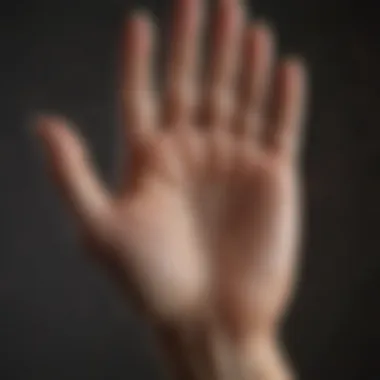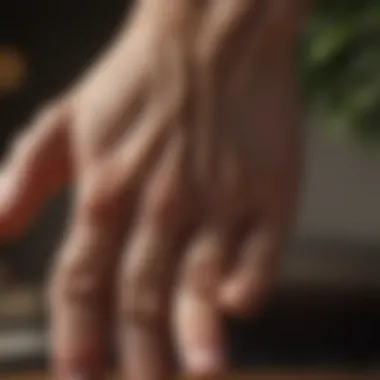Understanding Palmistry: Insights into Your Future


Intro
Palmistry, also known as chiromancy, is an ancient practice that interprets the lines and features of the palm to uncover insights into personality traits, emotional dispositions, and potential life paths. It is often intertwined with astrology, as both disciplines seek to unveil the subtleties of human existence. Understanding palmistry can serve as a crucial tool for individuals on their journey towards self-discovery and spiritual growth.
The guide ahead aims to demystify palmistry by exploring its historical roots, methodologies, and practical applications. You will find discussions on the significance of various lines and mounts present on the palm, as well as tips on how to approach a palm reading, whether it be for yourself or through an experienced practitioner. This comprehensive overview is designed especially for astrology enthusiasts, esotericists, and anyone curious about the deeper meanings hidden in their palms.
As you continue, it is important to approach palmistry with an open mind and a sense of wonder about the insights that can emerge. This primer not only addresses common misconceptions but also provides a roadmap for those looking to integrate palm reading into a broader exploration of their spiritual journey.
Understanding the Zodiac
While palmistry is focused on the interpretation of hand features, many practitioners also explore the connections between palmistry and astrology. This context can provide a richer understanding of personal traits and life experiences.
Overview of Zodiac Signs
The zodiac comprises twelve distinct signs, each representing unique characteristics and energies. These signs are:
- Aries
- Taurus
- Gemini
- Cancer
- Leo
- Virgo
- Libra
- Scorpio
- Sagittarius
- Capricorn
- Aquarius
- Pisces
Each sign has its own planetary ruler, which influences not only personality traits but also life challenges one may face.
Sign Traits and Characteristics
Understanding the traits associated with each zodiac sign can provide a deeper context for palmistry readings. Here are some brief insights into a few signs:
- Aries: Adventurous and confident, often impulsive but a natural leader.
- Taurus: Grounded and reliable, with a tendency towards stubbornness.
- Gemini: Curious and adaptable, skilled communicators with dual natures.
- Cancer: Sensitive and intuitive, often nurturing but can be overly protective.
Elemental Qualities
The zodiac signs can also be grouped according to the four classical elements: Fire, Earth, Air, and Water. Each element further defines characteristics of the associated signs, enhancing our understanding of individual behaviors.
- Fire: Aries, Leo, Sagittarius; passionate, energetic, and sometimes hot-headed.
- Earth: Taurus, Virgo, Capricorn; practical, stable, and often grounded in reality.
- Air: Gemini, Libra, Aquarius; intellectual, social, and prone to change.
- Water: Cancer, Scorpio, Pisces; emotional, intuitive, and often deep thinkers.
Understanding these elemental characteristics alongside palmistry can enrich interpretations and reveal how traits interplay with the insights derived from palm readings.
The combination of zodiac insights and palmistry can deepen the understanding of one’s self and others.
Prologue to Palmistry
Understanding palmistry is crucial for those who seek deeper insights into both oneself and others. This section will serve as a foundation for exploring the art of palm reading, providing clarity on what palmistry entails and the historical context that shapes its practice. By appreciating both the significance and origins of palmistry, readers can engage more meaningfully with their own palm readings, fostering a greater connection to the practice.
What is Palmistry?
Palmistry, often referred to as chiromancy, is the practice of interpreting the lines, shapes, and features of the palm to gain insights into an individual's character and potentially their life path. This ancient art argues that the palm reflects not just fate, but also personality traits, emotional states, and experiences. Practitioners analyze various aspects of the palm, including the major and minor lines, mounts, and the overall hand shape. Each feature holds relevance and an intricate pattern emerges from the details, enabling considerable depth in interpretation. The process can offer not only glimpses into one’s nature but also guidance for personal growth and decision making.
The Historical Context of Palmistry
Palmistry's roots extend deep into history, with traces found in various ancient civilizations across the globe. Its origins can be connected to ancient texts from India, China, and Greece. For instance, it was documented in the Shahnameh, a Persian work, and referenced by Aristotle, who saw it as a tool for discerning character. Over centuries, palmistry adopted varying interpretations and methods, tailored to cultural contexts.
In contemporary culture, palmistry can seem unconventional, yet its historical journey showcases its adaptability and enduring fascination. More than mere superstition, the practice has influenced many philosophers and psychics throughout history.


"The stories of our lives are right within our palms—waiting to be read."
Understanding this context enriches the practice, recognizing that it is not just about fortune telling; it serves as a means of reflection and self-exploration. This historical lens allows practitioners to appreciate the lineage of thought that has shaped how we approach palmistry today.
The Basics of Getting Your Palm Read
Understanding the basics of getting your palm read is crucial for anyone interested in palmistry. This segment serves as an introduction to what a palm reading entails, how to prepare for one, and the significance behind the process. It can demystify palmistry for newcomers and provide a better experience for those seeking insights into their personality and life journey.
What to Expect During a Palm Reading
When you decide to get a palm reading, it is essential to set clear expectations. A typical reading will begin with a conversation. The reader may ask about your life, your questions, or your interests. This helps them tailor the reading to your personal context.
During the reading, the palm reader will analyze the lines, shapes, and mounts on your palms. They might focus on:
- The major lines: The heart line, head line, and life line are the most significant in palmistry.
- Minor lines: These may reveal additional information about insight or traits.
- Fingers and their shapes: This can give clues about your personality.
- Mounts: The areas of fleshy prominence on the palm signify different planetary influences.
The process should feel interactive and enlightening. It is not just about predicting the future but understanding yourself better. Engaging openly with the reader enhances the experience.
Choosing a Qualified Palm Reader
Selecting the right palm reader is vital to ensure a helpful and insightful experience. Not everyone who claims to be an expert has the necessary skills or knowledge. When seeking a palm reader, consider the following factors:
- Experience: Look for someone who has several years in palmistry, as this usually indicates a depth of understanding.
- Reputation: Research online reviews and ask for recommendations from trusted sources. Social platforms like Facebook often have groups or pages where people share experiences with palm readers.
- Approach: Each palm reader may have their unique style. Finding one whose approach resonates with you will create a more comfortable environment.
- Specialization: Some readers focus on specific aspects of palmistry, like life paths or personality traits. Choose one that aligns with your interests.
- Initial Consultation: Many palm readers offer a short consultation before the full reading. Use this opportunity to gauge their comfort, openness, and approach.
Choosing the right palm reader sets the foundation for an enriching experience. Proper preparation, in terms of knowing what to expect and whom to choose, will greatly enhance your understanding of palmistry.
Understanding Palm Lines
Palm lines play a crucial role in palmistry, as they unveil layers of personality traits, emotional tendencies, and life events. Understanding these lines can facilitate a deeper self-awareness and enhance interpersonal relationships. Each line serves a specific purpose and contributes to a broader understanding of an individual's life path. This section will examine the major lines, which include the Heart Line, Head Line, and Life Line, in addition to the lesser-known minor lines with their meanings.
Major Lines: Heart Line, Head Line, and Life Line
The Heart Line, often found at the top of the palm, represents emotional aspects, particularly love and relationships. It can indicate how one approaches emotional issues. The depth and length of the Heart Line can hint at an individual's capacity for love, the ease with which they connect with others, and any emotional turmoil they might experience.
Next, the Head Line sits below the Heart Line and symbolizes intellectual pursuits and decision-making processes. This line reveals how a person thinks, learns, and resolves problems. Strong, clear Head Lines suggest clear thinking and focus, while fragmented lines might indicate indecision or muddled thinking.
Finally, the Life Line encapsulates physical vitality and major life changes. Contrary to popular belief, the length of the Life Line does not predict lifespan but reflects the quality of one's energy and health. Variations in this line can signify significant transitions or influence from external factors, like health and environment.
"The lines on your palm are a reflection of your inner self, telling tales of both your past and your potential future."
Minor Lines and Their Meanings
Beyond the major lines, the palm features several minor lines, which, though less prominent, still offer valuable insights. Common examples include the Fate Line, Sun Line, and Mercury Line. The Fate Line indicates life’s path and socio-economic progress. A prominent Fate Line points to career focus and ambition, whereas its absence might suggest a more spontaneous or undefined life.
The Sun Line, paralleling the Fate Line, sheds light on fame and recognition. A dominant Sun Line can reflect talent and success in the public realm. Finally, the Mercury Line relates to communication styles. A strong presence here hints at persuasive abilities, while its faintness may indicate challenges in self-expression.
To summarize, understanding the palm lines is fundamental to palmistry, as they are gateways to realizing deeper insights about oneself. By examining both major and minor lines, individuals can undertake a journey of self-discovery, ultimately enriching their understanding of life’s path.
Interpreting Palm Mounts
Interpreting palm mounts is a critical aspect of palmistry. These mounts, located at the base of each finger and the palm, correspond to different planets and their influence on personality traits. Understanding these mounts provides a more comprehensive reading. It can enhance insight into an individual's characteristics, motivations, and overall life tendencies.


The Mounts of the Planets
The mounts associated with the planets are essential for palm readers. Each mount reflects distinct traits and attributes related to the planet it represents.
Mount of Venus
The Mount of Venus is located at the base of the thumb. It signifies love, attraction, and affection. This mount is characterized by its softness. A well-developed Mount of Venus suggests strong emotions and charisma. It often denotes an individual who values relationships deeply. However, a flat or underdeveloped mount can signify emotional withdrawal or difficulty in forming connections.
Mount of Jupiter
Located under the index finger, the Mount of Jupiter relates to ambition and leadership. This mount indicates dominance, confidence, and a desire for success. Those with a prominent Mount of Jupiter are often seen as natural leaders. They may possess strong persuasive abilities. But, if this mount is overly developed, it may reflect arrogance or a need for control.
Mount of Saturn
The Mount of Saturn resides beneath the middle finger. It is associated with discipline, responsibility, and introspection. A pronounced Mount of Saturn shows a serious and contemplative nature. This trait often leads to wisdom and maturity. Conversely, a lacking mount could reflect instability or avoidance of responsibility.
Mount of Apollo
Found at the base of the ring finger, the Mount of Apollo symbolizes creativity and self-expression. Individuals with a well-defined Mount of Apollo tend to be artistic and appreciate beauty. This mount is linked to happiness and a zest for life. However, if it is underdeveloped, it might suggest a lack of enthusiasm or creativity.
Mount of Mercury
Situated at the base of the little finger, the Mount of Mercury represents communication and intellect. A strong Mount of Mercury implies good communication skills and cleverness. These individuals often excel in negotiation and persuasion. An ill-defined mount can indicate difficulties in expression or misunderstandings.
How Mounts Reflect Personality Traits
The mounts provide vital information about personality traits. Each mount has specific characteristics that can help interpret a person’s strengths and weaknesses.
- A prominent Mount of Venus might indicate someone with strong emotional connections.
- A well-developed Mount of Saturn often suggests a structured, responsible personality.
- People with a prominent Mount of Mercury usually excel in social settings and communication.
Understanding these mounts allows individuals to gain deeper insights into their personality. It can lead to better self-awareness and growth.
Common Misconceptions About Palmistry
Palmistry has many misconceptions that can cloud its true essence. Understanding these misconceptions is vital for a clearer grasp of what palmistry actually entails. Not only will this clarify its purpose, but it will also enhance the experience for anyone interested, whether they are getting a reading or learning how to read palms themselves.
Palmistry is Not Fortune Telling
One of the most common myths surrounding palmistry is the belief that it is merely a form of fortune telling. This perspective oversimplifies a rich and complex practice. Palmistry actually focuses on the interpretation of physiological traits found in the palm. By analyzing patterns, lines, and mounts, practitioners aim to offer insights into personality traits and potential future behaviors, rather than providing specific predictions about future events.
While some palm readers may incorporate elements that seem predictive, the foundation of palmistry lies in understanding the self rather than forecasting exact outcomes. The ability to glean meaningful information from palm lines reflects the reader’s skill and knowledge, not a capability to foresee the unknown. Through this lens, palmistry encourages self-awareness and personal growth, making it a valuable tool for those seeking deeper understanding of their life path.
Debunking Scientific Criticism
Another layer of misunderstanding comes from the scientific community, which often regards palmistry with skepticism. Critics usually argue that there is a lack of empirical evidence supporting the correlations that palmists claim to identify. Indeed, palmistry does not align with traditional scientific methodology, as it centers on subjective interpretations rather than measurable data. However, it’s crucial to note that palmistry operates within an esoteric framework rather than a scientific one.
Palmistry draws on observations and traditions that have evolved over centuries. Many practitioners argue that their insights—though not strictly scientific—can still hold value for personal reflection and understanding.
Personal Insights Through Palm Reading


Palm reading serves not only as a means of foretelling the future but also as a valuable tool for self-exploration. Through a careful examination of the lines and shapes on one's palm, individuals can achieve profound personal insights. This section will delve into the benefits of engaging with palmistry for personal growth and relationship understanding.
Self-Discovery and Personal Growth
Palm reading can act as a guide for self-discovery. By analyzing the major lines and mounts, individuals gain clarity about their motivations, strengths, and weaknesses. For instance, the heart line can reveal emotional tendencies, while the head line might indicate how one thinks. Understanding these attributes can foster personal growth. Here are several key elements to consider:
- Reflection: Think about what each line signifies. Recognizing patterns can lead to deeper introspection.
- Awareness: A palm reading can shed light on areas of life needing improvement, providing insight into how to channel energy effectively.
- Goal Setting: By understanding strengths and weaknesses, a person can create realistic goals aligned with their true self.
Engaging in palmistry can prompt discussions about life choices and direction. This encourages a mindset of continuous learning and adaptability. As such, palmistry becomes not just a reading but rather a navigating tool in life.
Enhancing Relationship Understanding
Relationships are central to human experience, and palm reading can enhance one's understanding of interpersonal dynamics. Each line and mount can reflect traits that influence how one relates to others. By comprehending these traits, individuals can improve their interactions, whether it’s romantic, familial, or social. Consider the following aspects:
- Empathy: Recognizing emotional patterns in oneself and others leads to deeper empathy and connection.
- Communication: Understanding personal communication styles can improve how individuals express themselves in relationships.
- Conflict Resolution: Knowledge of each other’s palm characteristics can aid in identifying potential sources of conflict, enabling proactive solutions.
Understanding your own lines and those of others can unravel many mysteries in personal relationships, fostering stronger bonds.
In summary, palm reading encapsulates more than just the art of prediction. It is a conduit for self-discovery and a mechanism for enhancing relational dynamics. The benefits stretch into various aspects of life, emphasizing the importance of integrating palmistry into personal development and relationship understanding.
Techniques to Improve Your Palm Reading
Improving your palm reading skills involves a combination of practice, observation, and the use of effective learning resources. Mastery in palmistry not only enhances one’s ability to interpret the various signals from the lines and mounts of the palm but also helps in developing a deeper understanding of human behavior and personality. This section covers different techniques which can amplify your proficiency in palm reading.
Practice and Observation
Consistent practice is fundamental in honing any skill, and palmistry is no exception. Working with hands that differ in structure, texture, and line formations can provide a broader perspective. Engage in real-world practice by reading palms of friends and family members. This offers a safe space for feedback, aiding in gradual improvement. Keeping a journal of readings can also track progress over time.
Observation plays a critical role. Pay attention to the nuances in each palm. The small variances in the length of lines or the shape of mounts can correlate with personal experiences and characteristics. Cultivating a keen eye will assist you in making more accurate assessments in the long term.
"The more palms you read, the better your intuition becomes. Observation goes hand in hand with understanding intention."
In addition, consider group practice workshops or local meetups with other palmists. They offer an excellent opportunity to network and share insights that can enhance your reading techniques.
Resources for Further Learning
Several educational materials cater to the diverse needs of those interested in palmistry. For foundational knowledge, books like Palmistry: How to Chart the Lines of Your Destiny by Roz Levine provide a robust introduction. Online platforms, such as forums on Reddit, serve as interactive hubs where enthusiasts discuss their experiences and find shared resources.
Webinars and online courses are also valuable; websites like Udemy offer structured learning experiences. Additionally, videos on platforms such as YouTube can offer visual guidance showing how to implement such techniques step-by-step.
Finding a mentor in the field can also accelerate your learning curve. Attending conferences or workshops allows the exchange of valuable techniques with experts.
Collectively, these strategies, along with patience and dedication, can significantly enhance your skills in palm reading and deepen your understanding of its intricate art.
Ending
In this article, we have explored the intricate relationship between palmistry and astrology, shedding light on its significance within the broader context of self-discovery. Palmistry serves as a bridge between one’s personal journey and the cosmic forces at play. Through examining the lines and mounts on our hands, we gain insights that can guide our decisions and enhance our understanding of personal traits.
The Value of Palmistry in Astrology
Palmistry is not merely a tool for predicting the future; it is a method for understanding oneself. By integrating palmistry with the principles of astrology, practitioners can uncover deeper layers of meaning. Here are key elements of how palmistry adds value to astrological practices:
- Personal Insight: Each line and mount on the palm correlates with various astrological influences. For example, the Life Line can reflect vitality and life events, while the Heart Line offers insights into emotional wellbeing.
- Holistic Understanding: Astrology provides a broader cosmic framework, while palmistry delves into individual manifestations. By examining both, you create a comprehensive picture of your life journey.
- Empowerment: Knowledge gained from palm readings can inform decisions and foster personal growth. Understanding your strengths and weaknesses allows for better navigation through life’s challenges.
“Palmistry does not take away our free will; rather, it highlights our inherent traits and tendencies, enabling better choices.”
For those who are already familiar with astrology, incorporating palmistry can enrich your practice. It complements astrological readings, making them more personalized and relevant. Additionally, learning palmistry requires observation and practice, essential skills for any dedicated esotericist.







